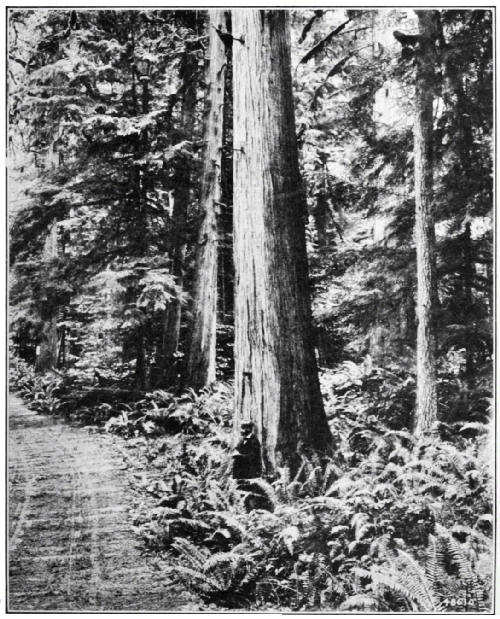
The Project Gutenberg EBook of The Forests of Mount Rainier National Park, by Grenville F. Allen This eBook is for the use of anyone anywhere at no cost and with almost no restrictions whatsoever. You may copy it, give it away or re-use it under the terms of the Project Gutenberg License included with this eBook or online at www.gutenberg.org Title: The Forests of Mount Rainier National Park Author: Grenville F. Allen Release Date: April 15, 2010 [EBook #31994] Language: English Character set encoding: ISO-8859-1 *** START OF THIS PROJECT GUTENBERG EBOOK FORESTS OF MT RAINIER NAT. PARK *** Produced by Greg Bergquist and the Online Distributed Proofreading Team at https://www.pgdp.net (This file was produced from images generously made available by The Internet Archive/American Libraries.)
Transcriber’s Note
The punctuation and spelling from the original text have been faithfully preserved.
DEPARTMENT OF THE INTERIOR
OFFICE OF THE SECRETARY
1916
For sale by the Superintendent of Documents, Government Printing Office, Washington, D.C. Price, 20 cents.
Remittances for these publications should be by money order, payable to the Superintendent of Documents, Government Printing Office, Washington, D.C., or in cash. Checks and postage stamps can not be accepted.
Features of the Flora of Mount Rainier National Park, by J.B. Flett. 1916. 48 pages, including 40 illustrations. 25 cents.
Contains descriptions of the flowering trees and shrubs in the park.
Mount Rainier and Its Glaciers, by F.E. Matthes. 1914. 48 pages, including 26 illustrations. 15 cents.
Contains a general account of the glaciers of Mount Rainier and of the development of the valleys and basins surrounding the peak.
Panoramic view of Mount Rainier National Park, 20 by 19 inches, scale 1 mile to the inch. 25 cents.
By G.F. Allen, United States Forest Service.
The remarkable development of the forests about the base of Mount Rainier results from climatic conditions peculiarly favorable to tree growth. The winters are mild and short. The ocean winds that pass through the gaps of the Coast Range are laden with moisture which falls in the form of rain or snow on the west slope of the Cascades. The trees are nourished by this moisture through a long season of annual growth, and form an evergreen forest which is, in some respects, the most remarkable in the world. This forest, distinguished by the extraordinary size and beauty of the trees and by the density of the stand, extends into the deep valleys of the rivers which have their sources in the glaciers. On the dividing ridges and in the upper stream basins the composition and character of the forest change with the increasing severity of the climate.
The distribution of the different species of trees according to the intervals of altitude at which they occur separate the forests of the Mount Rainier National Park into different types. The lines of separation are to some extent also determined by complex conditions of slope, exposure, and moisture. The successive forest belts are uniform in the composition of their central areas, but blend and overlap where they come together.
The low valleys of the main and west forks of White River, of the Carbon, the Mowich, the Nisqually, and the Ohanopecosh are covered with a dense and somber forest of fir, hemlock, and cedar. The trees, pushing upward for light, are very tall and free from limbs for more than half their height. Their tops form a continuous cover which the sunshine rarely penetrates, and on which the light snows of early winter fall and melt, without reaching the ground. Even in midsummer the light is soft and shaded, and the air cool and humid. In the wintertime the young growth is sheltered from wind and the severity of the cold is tempered by the protecting mountain ranges. Saved from fire by the uniform dampness of the air the trees grow until they decay and fall from old age. They are[Pg 2] succeeded by the suppressed younger trees. The forest remains mature, not uniformly sound and vigorous, yet not decreasing as a whole in size and volume. Individuals perish, but the character of the forest is constant. The deep alluvial soil covered with moss and decayed vegetation nourishes a luxuriant tangled undergrowth of vine maple, willow, and devil's-club. The forest floor is covered with a deep layer of decayed vegetation and is encumbered with fallen and mossy logs and upturned stumps. The explorer who leaves the trails must be a strong and active man if he can carry his pack 6 or 8 miles in a long summer day.
Ascending from the river bottoms to the lower slopes of the dividing ridges the forest becomes more open and the trees are smaller. Salal, Oregon grape, and huckleberry bushes take the place of the taller undergrowth of the valleys. Up to 3,000 feet the Douglas fir and the hemlock still are the dominant species. Above this altitude new species are found intermingled with the trees typical of the lowland, but forming a distinct forest type. The noble and amabilis fir appear, sometimes growing in pure stands, but more often associated with the Douglas fir and western hemlock at the lower limits of the type, and with alpine fir and mountain hemlock at the upper limit.
Nearly all the trees of this type have deep and wide-spreading roots which serve to hold in place the surface deposit of volcanic pumice which covers the slopes of the mountain. Evidence afforded by the after effects of forest fires in other parts of the Cascades indicates that the destruction of the forest on the mountain sides is followed by erosion. Heavy rains and the melting of the upper snow banks by warm Chinook winds combine to produce a surface run-off that denudes the steeper declivities down to the underlying bedrock.
At elevations above 4,500 feet the lowland trees have disappeared entirely. Subalpine species adapted to withstand the burden of deep snow take their place. Mountain hemlock, alpine fir, and Engelmann spruce grow singly and in scattered groups or form open groves alternating with grassy parks and rocky ridges. The symmetrical outline of the slender pyramidal crowns and rapidly tapering trunks of the spruce and alpine fir trees that stand singly on the greensward of the open parks bring to mind the closely trimmed cultivated evergreens that adorn city parks and lawns. Their lower branches reach the ground and the tops terminate in slender upright spires.
As timber line is approached tree growth is confined to dwarfed and flattened mountain hemlocks, alpine firs, and the white-bark pines firmly rooted among the crevices of the rocks.
The extreme limit of tree growth on Mount Rainier is 7,600 feet above sea level. There is no well-defined timber line. Scattered clumps of low stunted trees occur up to 7,000 feet. A few very small and flattened mountain hemlocks grow above this elevation. A very large part of the area above 4,500 feet consists of glaciers, talus slopes, barren rocky peaks, and open parks. Basins at the heads of canyons in the high mountains are usually treeless, on account of the great depth of snow which accumulates in them during the winter. On the steep, smooth upper inclines the snow banks frequently slip and form slides which acquire momentum as they rush down the mountain side and break and carry away large trees. Repeated snowslides in the same place keep the slopes nonforested, and their track is marked by light green strips of brush and herbage.
The transition of the forest from its lowland to its extreme alpine type is one of the most interesting features of a visit to the mountain. Entering the park at the western boundary close to the Nisqually River the road skirts the base of the lightly timbered spurs and passes into a forest of large and old Douglas fir and western hemlock. Red cedars grow along the streams that cross the road. Little yew trees and vine maples mingle with the young conifers that form the undergrowth; the gloom of the forest is occasionally relieved by the white bark of alders and the smooth gray stems of the cottonwoods that grow on the sandy bank of the Nisqually. After the road crosses the Rainier Fork, noble fir and amabilis fir appear, but the Douglas fir and western hemlock are still the prevailing species.
Above Longmire Springs the noble and amabilis fir, mixed with western hemlock, become the dominant type. The trees are shorter and the branches heavier. Mountain ash and yellow cypress grow on the margin of the mountain streams. Huckleberry bushes take the place of the taller undergrowth of the valley.
Above Narada Falls the forest is more open, and the trees are still smaller. Mountain hemlock and alpine fir succeed the trees of the lower slope. Little glades and mountain meadows are seen. They become larger and more numerous and the traveler soon enters the open park of Paradise Valley, in which are but scattered groves of trees. The same successive altitudinal types are met in ascending to Moraine and Grand Parks by way of the Carbon Valley, and in following the Mowich watershed, Crater Lake, and Spray Park routes.
Approaching the park from the east the routes pass through open western yellow pine forests and western larch stands. Since Mount Rainier is west of and apart from the summit line, these species which are peculiar to the eastern slope are not found within the limits of the park.
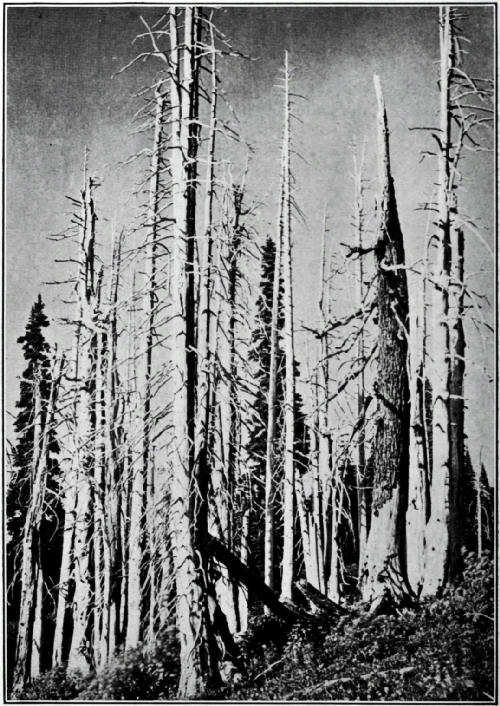
Photograph by A.H. Barnes.
Notwithstanding the shortness of the summer season at high altitudes, the subalpine forests in some parts of the park have suffered severely from fire (fig. 1). The bare white trunks of fire-killed amabilis and alpine firs bear witness to numerous fires which occurred[Pg 5] from time to time before the regulations governing the park went into effect. The little resin pockets in the bark of these trees blaze fiercely for a short time and the heat separates the bark from the trunk. In this way the tree is killed, although the naked trunk is left untouched by fire. The destruction of the alpine forest in this way is often erroneously attributed to disease or to the depredations of insects.
There has been little apparent change in the alpine burns within the last 30 years. Reforestation at high altitudes is extremely slow. The seed production is rather scanty and the ground conditions are not favorable for its reproduction. It will take more than one century for nature to replace the beautiful groves which have been destroyed by the carelessness of the first visitors to the mountain.
At low elevations the forest recovers more rapidly from the effects of fire. Between the subalpine areas and the river valleys there are several large ancient burns which are partly reforested. The most extensive of these tracts is the Muddy Fork burn. It is crossed by the Stevens Canyon Trail from Reflection Lakes through the Ohanopecosh Hot Springs. This burn includes an area of 20 square miles in the park and extends north nearly to the glaciers and south for several miles beyond the park boundary nearly to the main Cowlitz River. The open sunlit spaces and wide outlooks afforded by reforested tracts of this character present a strong contrast to the deep shades and dim vistas of the primitive forest. On the whole they have a cheerful and pleasing appearance, very different from the sad, desolate aspect of the alpine burns which less kindly conditions of climate and exposure have kept from reforestation.
The original forest was fire killed many years before the coming of the white man. A few naked and weather beaten stubs are still standing. Only the larger of the fallen trunks remain, and these are rotten except for a few seasoned and weatherworn shells. The second growth is of all ages, from seedlings to trees 12 to 14 inches in diameter. Vine maple, willow, and mountain ash have sprung up along the streams and the hillsides are covered with huckleberry bushes and a variety of grasses and flowering plants.
Similar old burns are found on the ridge between Huckleberry Creek and White River, in the northeastern part of the park, and on the ridge between Tahoma Creek and Kautz Creek below Henrys Hunting Ground.
The old burns in the middle altitudes of the park occupy regions once frequented by the Klickitat Indians. Every summer parties of hunters and berry pickers from the sagebrush plains crossed the Cascades with their horses. They followed the high divides and open summits of the secondary ridges until they came around to the open parks about Mount Rainier where they turned their horses out[Pg 6] to graze and made their summer camp. The woman picked huckleberries and the men hunted deer and goats. They made great fires to dry their berries and kindled smudges to protect their horses from flies. It was also their custom to systematically set out fires as they returned. Burning made the country better for the Indians. The fires kept down the brush and made it more accessible. Deer could be more easily seen and tracked and the huckleberry patches spread more widely over the hills.
No considerable part of the lower forests of the park has been burned. The principal danger is from lightning. However, few of the trees struck are ignited and these fires are usually extinguished by the rain. On account of the coolness of the air and its greater humidity the fire danger in the forests on the lower slopes of Mount Rainier seems much less than it is in corresponding situations in the main range of the Cascades.
Trees grow more rapidly at low altitudes than at higher and cooler elevations. Under similar conditions some species increase in size faster than others, but the rate of growth depends principally upon environment. The average increase at the stump in valley land is about 1 inch in 6 years. A Douglas fir growing along the stage road between the park boundary and Longmire's, at the age of 90 to 120 years may have a breast diameter of 20 inches and yield 700 feet of saw timber. But many of the trees of this size may be much older on account of having grown in the shade or under other adverse conditions. The trees between 200 and 300 years of age are often 40 to 50 inches in diameter and may yield an average of from 2,700 to 5,500 board feet. The largest Douglas firs are sometimes over 400 years old and 60 to 70 inches in diameter. Such trees when sound will produce over 8,000 feet of lumber.
The western red cedar has a shorter and more tapering trunk and its volume in board feet is proportionally smaller. A tree 50 inches in diameter and 175 feet high contains about 3,400 board feet.
The size of the trees decreases rapidly at higher elevations. In the subalpine forest the annual growth is very small. At elevations of 6,000 feet the white-bark pine requires 200 years to attain a diameter of 10 or 12 inches. The annual rings are so close together that they can not be distinguished without a magnifying glass.
The Douglas fir (figs. 2, 3, 4, and 5) is the best known and the most important timber tree of western North America. It is found[Pg 7] from British Columbia southward to northern Mexico. The finest forests occur in Oregon and Washington at low elevations. The Douglas fir is common in the park up to 3,500 feet, sometimes in nearly pure stands, but more often mixed with other species. It grows in all situations. In the higher mountains it prefers warm southern exposures and is seldom found on wind-swept ridges. It seeds annually, but most profusely at intervals three or four years apart. The red squirrels gather and store large quantities of the cones in order to provide a supply of the seeds for their winter rations. The growth of the young tree is very rapid. As the tree becomes older the rate of growth varies with the situation and the character of the soil so that the size does not closely determine the age of the tree.
The Douglas fir is a long-lived tree, and specimens are occasionally found 250 to 270 feet high and over 8 feet in diameter and between 400 and 500 years in age. It reaches its greatest height and most perfect proportions in mature even-age stands growing on fairly moist well-drained bench lands. Under these conditions it is a very tall and beautiful tree. The trunk is straight, round, and free from branches for two-thirds of its height and tapers gently to the crown. The dark-brown deep-furrowed bark is 5 to 10 inches thick at the base of the tree.
The Douglas fir ranks first among the trees of the Pacific slope in importance for the production of lumber. It is often sold under the name of Oregon pine. Lumber dealers class the coarse-grained reddish wood produced by the young growth in open forests as "red fir." The older growth produced when the forest is more dense is a finer grained and more valuable wood, sold under the name of "yellow fir."
The Douglas fir is used for nearly all purposes where durability, strength, and hardness are desirable. It is made into dimension timbers, lumber, flooring, and is particularly adapted for masts and spars. The lumber is shipped by rail to the Middle Western States. The foreign cargo shipments are made to all parts of the world. The greatest amount goes to Australia, the west and east coasts of South America, China, the United Kingdom, and Europe, Japan, and the South Sea Islands. Coastwise shipments are made to California, Alaska, and Panama. Large quantities of the seed of this tree are sent to Europe, where the Douglas fir is grown for timber and for ornament.
The western red cedar (title page and fig. 5) ranges from south-eastern Alaska to northern California. It is a common tree in the park. It occurs in patches along the river bottoms where the flat scalelike foliage is conspicuous among the needle-shaped leaves of the hemlock and fir. The bark is fibrous in appearance and may be readily separated into long strips. The trunks of the older trees are swelled and irregularly fluted at the base. The leaves are fragrant[Pg 10] and the wood has a pleasing aromatic odor. Nearly all the large trees are hollow at the butt. The roots spread laterally to a great distance, but extend only for a short distance below the surface of the ground. The tree is easily overthrown by the wind and usually grows in sheltered localities. On account of the thinness of the bark it is easily killed by fire.
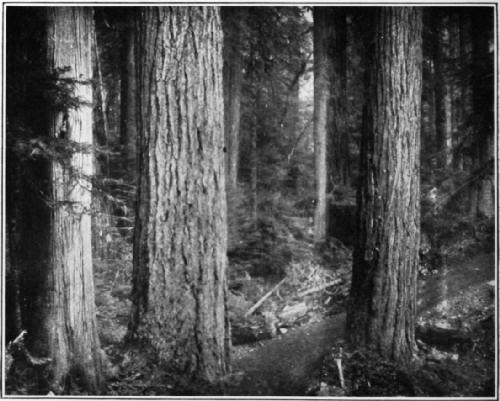
Photograph by A.H. Denman.
The red cedar flourishes on fertile and well-watered soils near sea level, where it grows to an enormous size. In the park it is a smaller tree, 150 to 170 feet high and rarely more than 4 or 5 feet through above the swollen butt. It grows occasionally up to an altitude of 4,000 feet, but is a small and insignificant tree in the high mountains.
In the sapling stage the red cedar grows rapidly. The mature tree increases very slowly in size. It exceeds all other trees in the Cascades in longevity. Individuals more than 500 years old are not uncommon and there is a well-authenticated instance where the annual rings indicated a growth of more than 1,100 years.
While the red cedar forms no great proportion of the forest of the Pacific Northwest, it is peculiarly valuable to the pioneer on account of the durability of the wood and the ease with which it can be split[Pg 11] into boards, shakes, and planking. The early settlers used cedar split by hand as a substitute for sawn lumber in flooring and finishing their cabins and for the tables and shelves with which they were furnished. The Indians hollowed the great trunks with fire and made them into canoes, some of which were large and seaworthy enough to be used on the Sound and in making voyages along the coast. They wove the fibrous roots into baskets that carried water and plaited the bark into matting. The wood of the red cedar is reddish brown in color. It is soft, light, and very brittle, but very durable. It is extensively used for shingles, the manufacture of which forms one of the important industries of the State. The clear logs are sawed into lumber used for siding, interior and exterior finish, moldings, tank stock, and similar purposes. Common logs are utilized for shingles. In many localities the entire tree is cut into 52–inch bolts, which are hauled to the mills or floated to them down the streams.
The western red cedar makes excellent posts and rails for farm fences. The young trees are used for telegraph and telephone poles.
Next to the Douglas fir the western hemlock is the most abundant tree in the forests of Oregon and Washington. It occurs from Alaska southward to northern California. About Mount Rainier it is found up to an altitude of 5,000 feet. In the river valleys in moist situations it is a large tree, sometimes reaching a height of 250 feet and a diameter of 5 feet. On the high ridges it is stunted. It grows best on moist deep soils in dense forests, but thrives under almost all conditions of soil and exposure if provided with plenty of moisture.
Western hemlock (figs. 6 and 7) is usually associated with Douglas fir and red cedar, but sometimes forms a forest of nearly pure growth. The hemlock produces abundant seed each year, although it is more prolific at irregular intervals. The seeds germinate readily on decayed moss and rotten wood as well as upon the mineral soil. Seedlings frequently grow on fallen logs and extend their vigorous roots around the side until they reach the ground and become firmly anchored in it. Young hemlocks thrive in the shade. On logged-off areas which have not been burned over and which are partially shaded by uncut trees, the reproduction of hemlock springs up, to the exclusion of the more valuable Douglas fir.
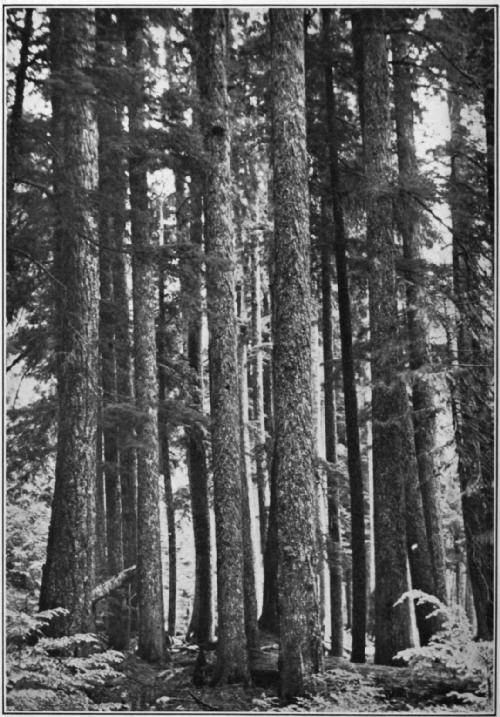
Photograph by A.H. Barnes.
The hemlock is long lived and grows slowly. The largest trees are from 200 to 500 years old and are usually hollow-hearted. The bark is thin and the tree very easily killed by ground fire. The wood of the hemlock is tough, light, and straight grained. It is not as durable as the Douglas fir and decays rapidly when exposed to the weather. The clear lumber is suitable for interior finish. The wood is also used for flooring, joists, lath, and paper pulp. The common and rough lumber does not find a ready market, except for the limited amount used in temporary construction. The western hemlock[Pg 13] is, however, superior to the eastern hemlock, and its value will probably be recognized as its usefulness for many purposes becomes better known.
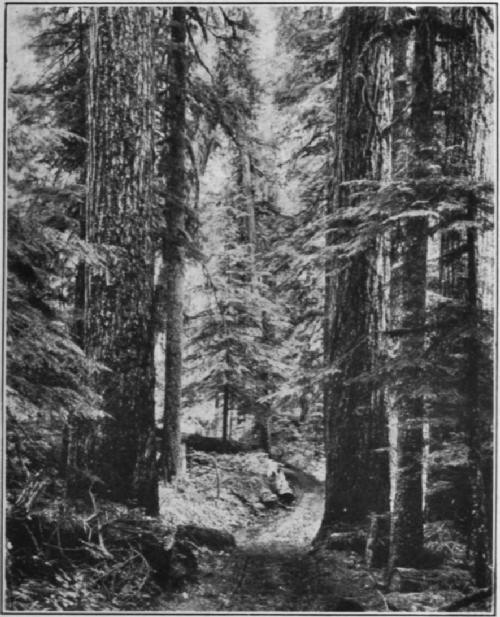
Photograph by A.H. Denman.
The western white pine (fig. 8) is found from southern Alaska to northern California. In the park it occurs occasionally up to 4,000 feet. It usually grows on level benches and gentle slopes associated with Douglas fir, western hemlock, and noble and amabilis fir. It reaches its best development at elevations of from 3,000 to 3,500 feet, where it attains a height of 150 feet and a diameter of 40 inches. The shaft is straight, cylindrical, and clear of limbs. It bears a small, narrow crown of drooping branches. In open areas, where it is exposed to sunlight, its mode of growth is wholly different. The[Pg 14] trunk is short, rapidly tapering, and bears wide-spreading branches nearly to the ground. At high elevations the western white pine is very short and stunted.
Although the western white pine is not a common tree in the park, it is often noticed on account of its abundance of slender, pendant cones, 6 to 10 inches long. They mature every two years and shed their seed early in September. The seed are provided with long wings and are often carried by the wind for a great distance from the parent tree.
The wood is light, soft, free from pitch, and the most valuable of any of the pines of the Cascades. It is used for interior finish, pattern making, and other purposes. The supply of this tree is so limited that it is not of great commercial importance in the Mount Rainier region.
Amabilis fir (figs. 9 and 10) ranges from southern Alaska to Oregon. It is abundant in the park at elevations from 2,500 to 5,000 feet on level bench lands, and gentle slopes with a northern exposure. It is rarely found in unmixed stands, but is usually associated with western hemlock, Douglas fir, and noble fir. The largest trees are 150 to 180 feet high and 3 to 5 feet in diameter. In dense forests the stem is free from branches for 50 to 100 feet.
At altitudes over 4,000 feet, small amabilis firs often occur in clusters and open groves. The trunk is covered with branches which grow to the ground, turning downward and outward in long graceful curves, admirably adapted to withstand the pressure of the frozen snow. The foliage is a deep and brilliant green, forming a strong contrast to the dark-purple cones. The seeds ripen each year[Pg 16] early in October. Like the seed of the other alpine species of trees that grow in the cold and humid climate of the high Cascades, they soon lose their vitality when stored in dry places. The amabilis fir is grown in Europe as an ornamental tree. Under cultivation it loses much of the natural grace and beauty which it acquired in adapting itself to the deep snows and long winters of its native environment.
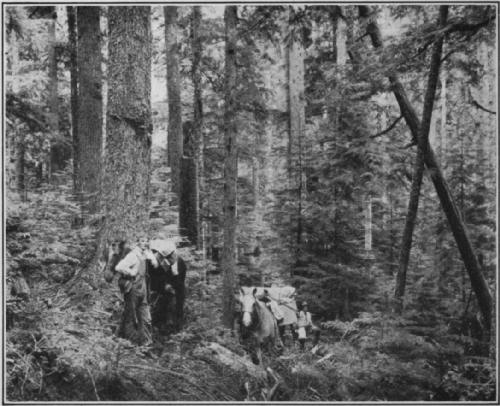
Photograph by Geo. O. Ceasar.
The bark is thin and the tree is easily killed by fire. The wood is straw colored, compact, and straight grained. It is not strong and splits easily. It is sold to some extent under the name of larch or mixed with inferior grades of fir and hemlock. The lumber is of little value commercially.
The noble fir (figs. 11 and 12) is a common mountain tree in the western parts of Washington and Oregon. Like amabilis fir, it is usually called larch by lumbermen. About Mount Rainier it grows at elevations of from 3,500 to 5,000 feet in dense stands associated[Pg 17] with amabilis fir, western hemlock, and Douglas fir. The noble fir avoids steep side hills and exposed situations. In moist soils on flats and gentle slopes it often reaches a height of from 150 to 200 feet. The tall and upright trunk supports a rounded crown of bluish green foliage, which is very noticeable among the purer green leaves of its associates. The branches are short, thick, and crowded with stiff, flattened leaves, which turn upward and outward. The light-green bract-covered cones are sometimes 6 inches long and nearly 3 inches thick. They ripen early in September. Seed is borne every year, although in some seasons it is much more abundant than in others.
The wood is strong, close grained, and elastic. It is used for lumber and particularly for inside finishing. The noble fir is a slow-growing and long-lived tree. Old trees in mixed forests are easily distinguished from the associated species by the ashy-brown outer bark broken into large irregular plates.
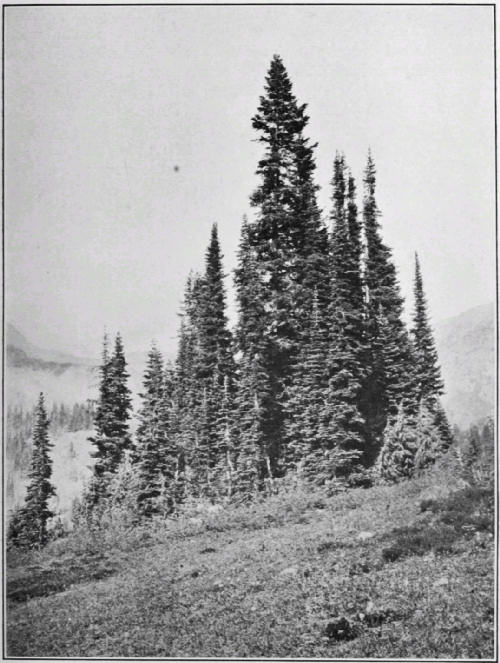
Photograph by A.H. Barnes.
The alpine fir (fig. 13) ranges from Alaska to New Mexico. It is a common tree in the park at elevations above 4,500 feet. It is a tree of the high mountains and with the white bark pine and the mountain hemlock, is found up to the limit of arborescent life. It[Pg 20] demands moisture and is generally restricted to regions of deep snowfall.
The alpine fir occurs in unmixed stands, but is often associated with the mountain hemlock. At the lower levels of its range it is a fair-sized tree 50 or 60 feet high. The crown of deep-green foliage is broad at the base and tapers to the top, where it terminates in a slender, pointed tip. At its upper limit it becomes a stunted shrub, with wide extended branches resting on the ground.
The alpine fir bears upright clusters of deep-purple cones. It seeds sparingly each year. The seasons of heavy seed production occur at intervals of three or four years. The wood is soft and splits easily. It is of no commercial value. The tree is easily killed by fire, which blisters the thin bark and frequently springs into the drooping lower branches.
The grand fir (fig. 14), like several other species, is generally given the name of white fir on account of its smooth, light-colored bark. It is a common tree in the river bottoms from British Columbia south to northern California. In the Mount Rainier National Park it occurs up to 4,000 feet. The grand fir is a moisture-loving tree and is usually found firmly rooted in deep alluvial bottom lands along the banks of streams. With the Douglas fir, hemlock, and red cedar it forms the dense forest characteristic of the lower mountain valleys.
In favorable conditions the grand fir grows to a height of from 100 to 200 feet and is a noble and stately tree. The trunk tapers rapidly and bears a rounded pyramidal crown. In dense forests the trunk is clear for half its height, but where the trees stand in the open it carries its branches nearly to the ground. The leaves are a bright and shining green. The large light-green cones mature early in the fall. The wood is soft and very heavy before it is seasoned. It rots in a very short time when laid on the ground. When dry it is white, coarse-grained, light, and odorous. It is used for interior finish and for crates and packing boxes, but is of little value commercially.
The Engelmann spruce (fig. 15) is a mountain tree ranging from British Columbia to Arizona and New Mexico. It is common along the summit and on the east side of the Cascade Range and occurs on the northeastern and eastern slopes of Mount Rainier at elevations of from 3,500 to 6,000 feet.
This tree requires a moist soil and prefers cool northern exposures. Up to 5,000 feet it commonly grows in sheltered basins at the head[Pg 21] of canyons and in stream valleys. At its upper limits it is common on flats and depressions and about lakes on level summits. It avoids steep mountain sides and exposed situations.
The Engelmann spruce is easily distinguished from its associates by its stiff, bluish-green pointed leaves, which prick the hand when[Pg 22] they are grasped. In the mountain parks it is a handsome tree 50 to 60 feet high. When it stands apart from other trees the lower branches are thick and long and extend to the ground. The crown is very broad at the base, but narrow and spirelike at the top. The Engelmann spruce reaches its best development at low elevations, where it often grows in dense, pure stands. Under these conditions it reaches a height of 100 feet. The bole is straight and free from limbs and the top is short and compact.
The young cones are massed in upright green and purple clusters at the tips of the upper branches. They are notable for the purity and brilliance of their coloring. As they mature they become pendant and fade to a light brown. The seed is produced in abundance nearly every year, although small and seedling trees are not usually numerous.
The wood is soft, white, compact, and even grained. It is free from pitch and odor. It is valuable for boxing, cooperage, and certain[Pg 23] kinds of finish. It is also an excellent material for the tops of violins and other stringed instruments. The Engelmann spruce is, however, of little importance as a timber tree on account of its scarcity and the scattered stands in which it grows. It is a long-lived tree unless attacked by fire, to which it is very vulnerable.
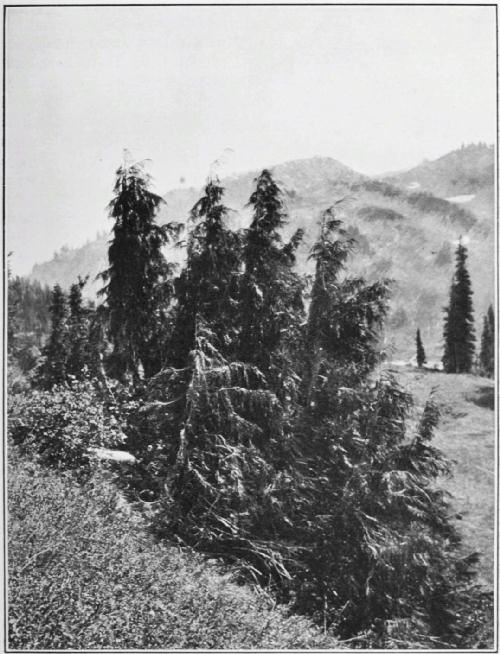
Photograph by A.H. Barnes.
Yellow cypress (fig. 16) ranges from the seacoast of southern Alaska south to the mountains of Washington and Oregon. It occurs[Pg 24] in the park up to the elevation of 7,000 feet. It is common on northern exposures, along streams, and in basins at the head of canyons. It also grows on crests and ridges, where the frequent showers and fogs supply the moisture which it demands. In sheltered localities it grows to a height of 75 or 80 feet, but it is commonly a small tree with, a bent and twisted stem, which, with its pendulous branches, presents a somewhat scrubby appearance. The foliage is green, sometimes with a bluish tinge. It resembles that of the common western red cedar, but the leaves are sharper, more pointed, and rougher to handle. The small, rounded, inconspicuous cones are produced somewhat sparingly. The bark of the young tree is red. On the mature tree it becomes gray and fibrous. The wood is yellow, close grained, and aromatic. Unlike that of the western red cedar, the trunk is usually sound to the center. The wood is used for boat building and cabinetwork. It is very durable.
The yellow cypress grows very slowly, particularly at high elevations. The number of annual rings on trees 15 to 20 inches in diameter indicate that they are over 200 years old.
Lodgepole pine (fig. 17) is widely distributed from Alaska to Lower California and eastward through the Rockies to Dakota and Colorado. It occurs sparingly in the park up to 5,000 feet above sea level. It adapts itself easily to the different conditions of soil, moisture, and exposure.
This tree varies greatly in the different regions where it is found. About Mount Rainier it does not often exceed 20 to 40 feet in height[Pg 25] and is often a much smaller tree. It produces cones at the age of 5 to 7 years. The foliage is a yellowish green. At high elevations the leaves have a peculiar whorled appearance which gives it a different aspect from that of the other pines. The short, heavily limbed trunk bears no resemblance to the tall and slender shaft of the lodgepole pine of the Rocky Mountains. The root system is shallow and the tree is easily fire killed. The wood of the variety which grows in the park is of no commercial value.
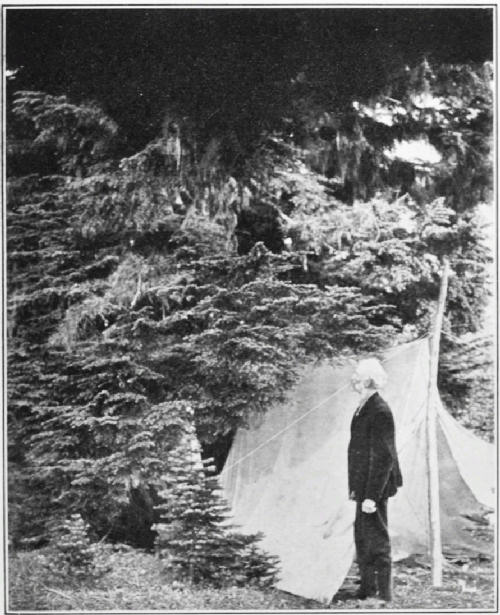
Photograph by A.H. Denman.
The mountain hemlock (figs. 18, 19, and 20) is found on the Pacific coast from the Sierras of California to the northern part of Alaska[Pg 26] where it grows at sea level. On Mount Rainier it occurs at altitudes of from 3,500 to 7,500 feet. It forms dense forests under 4,500 feet, where it is often a fair-sized tree 50 to 90 feet high. With the ascent of the mountain it diminishes in height and the branches become gnarled and twisted. Near timber line the trunk is dwarfed and bent at the base and the crown becomes a flattened mass of branches lying close to the ground (fig. 20).
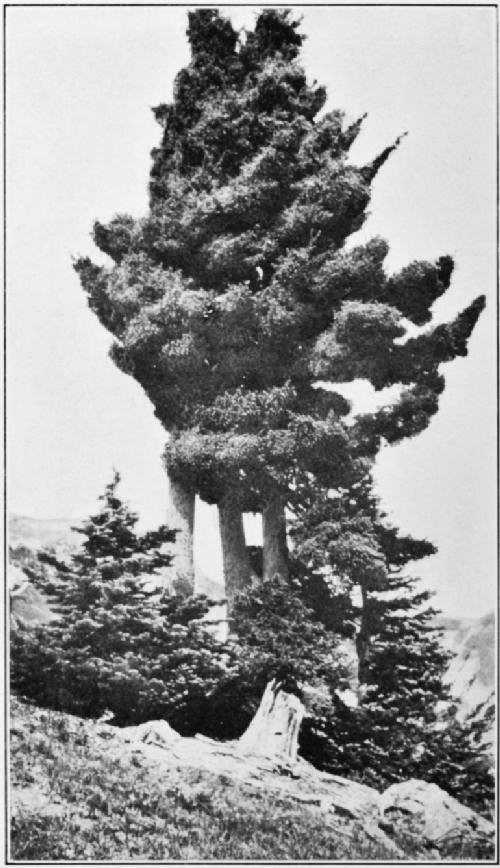
Photograph by Geo. O. Ceasar.
The mountain hemlock is abundant on high, rocky ridges, but the best stands are on cool, moist soil at the heads of ravines, on flats, and on gentle slopes with a northern exposure.
This tree seeds every year. In good seed years the upper branches are laden with a profusion of beautiful, deep-purple cones, often in such abundance as to bend down the branchlets with their weight. The reproduction is slow. In the high mountains the trees are buried in snow from October to late in June, and the growing season is very short.
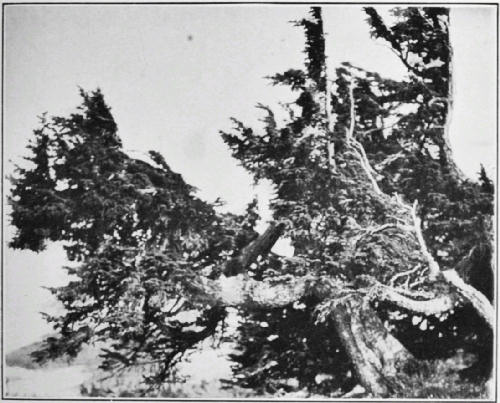
Photograph by A.H. Denman.
The white-bark pine (fig. 21) grows close to timber line in the mountains of the Pacific coast from British Columbia to southern California. In the Canadian Rockies it extends north to the fifty-third parallel. It is the most alpine of all the pines. Its lower limit on Mount Rainier is about 5,000 feet above sea level. In sheltered places where the soil is deep the trees are sometimes 30 to 40 feet high and 20 inches in diameter. The trunks are free from limbs for 8 or 10 feet. The outer bark, from which the tree derives its name, consists of thin, light-gray scales.
As the white-bark pine advances up the mountain its habit changes rapidly. The stem shortens and becomes gnarled and twisted. The tough, flexible branches reach the ground and spread over it to a[Pg 28] great distance from the tree. On rocky summits and the bleak crests of wind-swept ridges the twisted trunk and branches are quite prostrate and the crown is a dense flattened mass of foliage.
The roots of the tree are deep, long, and tenacious. They spread wide and deep and cling so firmly to the rocks that the tree is rarely overthrown by the violent winds that sweep over the mountain.
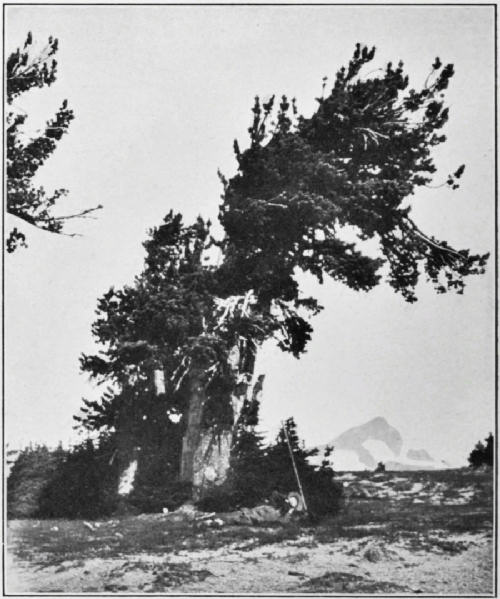
Photograph by A.H. Denman.
The thick, purple cones require two years to mature. They ripen early in September and produce chocolate-brown seeds a little larger than a grain of corn. They are much relished by the Klickitat Indians, who go to considerable pains to secure them. The wood is close grained and resinous. It makes excellent fuel for the camp fires of sheep herders and mountain travelers.
The western yew is found from southern Alaska to northern California. It occurs in the park up to 4,000 feet, growing in rich, gravelly soil on moist flats and benches and in deep ravines. It is a small branching tree, rarely over 20 feet high. The bark is purple or reddish brown. The branches extend almost to the ground. It bears a small, bright, amber-red berry.
The dark-brown or red heartwood is very tough, hard and heavy. It takes a fine polish and is used for fancy cabinetwork. The Indians use it for spear handles, bows, and fishhooks.
The silva of the Western Cascades is rich in evergreens remarkable for their size and beauty. The deciduous trees are few and insignificant. The forests of the park are almost wholly coniferous. Vine maple and willow are found as undergrowth. On the margins of rivers there are occasional groves of alders and cottonwoods. The lighter hues of the branching trunks and the changing tints of the[Pg 30] foliage in these patches of broad-leaved woodland present a pleasing diversity to the evergreen forest.
Broadleaf maple (Acer macrophyllum) (fig. 22), the largest of the Pacific coast maples, ranges from Alaska to southern California. Near sea level it often attains a height of 50 or 60 feet. In the park it is a short-stemmed, branching tree, occasionally found on the borders of streams. It grows at elevations under 3,000 feet.
Vine maple (Acer circinatum) (fig. 23) is abundant from British Columbia to northern California. On rich river bottoms it is sometimes 15 to 20 feet high and 6 inches in diameter. In the park it is usually a bush or low shrub with a bent and curiously crooked stem, growing along streams and as undergrowth in the forest. It is very common up to 3,000 feet. In autumn the leaves are a bright scarlet. The wood is tough and elastic and makes a hot and lasting fire.
Red alder (Alnus oregona) (fig. 24) occurs from Alaska to southern California. It is common about Mount Rainier, in river bottoms, on the banks of large streams, and in swampy places. It usually grows to a height of 30 or 40 feet. The bark varies from nearly white to light gray. It is the most abundant of all the deciduous trees in the park.
Black cottonwood (Populus trichocarpa) (fig. 25) is common from Alaska to southern California. It is occasionally found in the park up to 4,000 feet. It grows along streams and on sandy river bottoms often associated with the alder. The leaves are almost always in motion, very gentle winds being sufficient to make them twinkle and turn.
The wood is soft, but tough and compact. It is used for staves, woodenware, wood pulp, trunks, barrels, and for drawer bottoms.
[1] This species is known as arbor vitæ in Glacier Park.
[2] This species is known as silver fir in Crater Lake Park.
[3] This species is known as balsam in Glacier and Yellowstone Parks.
[4] This species is known as silver fir in Yellowstone and Glacier Parks.
[5] This species is known as Oregon yew in Crater Lake National Park and as yew in Yellowstone and Glacier Parks.
[Roman numerals indicate pages containing descriptions; italic numerals indicate pages containing illustrations.]
Abies amabilis 15–16, 15, 16
grandis 20, 21
lasiocarpa 19–20, 19
nobilis 17–19, 17, 18
Acer circinatum 30, 30
macrophyllum 29, 29
Alder, red (Alnus oregona) 30, 31
Alnus oregona 30, 31
Alpine fir (Abies lasiocarpa) 19–20, 19
Amabilis fir (Abies amabilis) 15–16, 15, 16
Arbor vitæ. See Western red cedar.
Balsam. See Alpine fir.
Black cottonwood (Populus trichocarpa) 30–32, 31
Broadleaf maple (Acer macrophyllum) 29, 29
Cedar, western red (Thuja plicata) 9–11, 10
Chamaecyparis nootkatensis 23–24, 23
Cottonwood, black (Populus trichocarpa) 30–32, 31
Cypress, yellow (Chamaecyparis nootkatensis) 23–24, 23
Douglas fir (Pseudotsuga taxifolia) 6–8, 7, 8, 9, 10, 12, 13
Engelmann spruce (Picea engelmanni) 20–23, 22
Fir, alpine (Abies lasiocarpa) 19–20, 19
amabilis (Abies amabilis) 15–16, 15, 16
Douglas (Pseudotsuga taxifolia) 6–8, 7, 8, 9, 10, 12, 13
grand (Abies grandis) 20, 21
noble (Abies nobilis) 17–19, 17, 18
silver. See Fir, amabilis; Fir, grand.
Grand fir (Abies grandis) 20, 21
Hemlock, mountain (Tsuga mertensiana) 25–27, 25, 26, 27
western (Tsuga heterophylla) 11–13, 12, 13, 16
Larch. See Noble fir; Amabilis fir.
Lodgepole pine (Pinus contorta) 24–25, 24
Maple, broadleaf (Acer macrophyllum) 29, 29
vine (Acer circinatum) 30, 30
Mountain hemlock (Tsuga mertensiana) 25–27, 25, 26, 27
Noble fir (Abies nobilis) 17–19, 17, 18
Oregon yew. See Western yew.
Picea engelmanni 20–23, 22
Pine, lodgepole (Pinus contorta) 24–25, 24
western white (Pinus monticola) 13–15, 14
white-bark (Pinus albicaulis) 27–28, 28
Pinus albicaulis 27–28, 28
contorta 24–25, 24
monticola 13–15, 14
Populus trichocarpa 30–32, 31
Pseudotsuga taxifolia 6–8, 7, 8, 9, 10, 12, 13
Red alder (Alnus oregona) 30, 31
cedar, western (Thuja plicata) 9–11, 10
Silver fir. See Amabilis fir; Grand fir.
Spruce, Engelmann (Picea engelmanni) 20–23, 22
Taxus brevifolia 28–29
Thuja plicata 9–11, 10
Tsuga heterophylla 11–13, 12, 13, 16
mertensiana 25–27, 25, 26, 27
Vine maple (Acer circinatum) 30, 30
Western hemlock (Tsuga heterophylla) 11–13, 12, 13, 16
red cedar (Thuja plicata) 9–11, 10
white pine (Pinus monticola) 13–15, 14
yew (Taxus brevifolia) 28–29
White-bark pine (Pinus albicaulis) 27–28, 28
White pine, western (Pinus monticola) 13–15, 14
Yellow cypress (Chamaecyparis nootkatensis) 23–24, 23
Yew, Oregon. See Yew, western.
western (Taxus brevifolia) 28–29
End of the Project Gutenberg EBook of The Forests of Mount Rainier National
Park, by Grenville F. Allen
*** END OF THIS PROJECT GUTENBERG EBOOK FORESTS OF MT RAINIER NAT. PARK ***
***** This file should be named 31994-h.htm or 31994-h.zip *****
This and all associated files of various formats will be found in:
https://www.gutenberg.org/3/1/9/9/31994/
Produced by Greg Bergquist and the Online Distributed
Proofreading Team at https://www.pgdp.net (This file was
produced from images generously made available by The
Internet Archive/American Libraries.)
Updated editions will replace the previous one--the old editions
will be renamed.
Creating the works from public domain print editions means that no
one owns a United States copyright in these works, so the Foundation
(and you!) can copy and distribute it in the United States without
permission and without paying copyright royalties. Special rules,
set forth in the General Terms of Use part of this license, apply to
copying and distributing Project Gutenberg-tm electronic works to
protect the PROJECT GUTENBERG-tm concept and trademark. Project
Gutenberg is a registered trademark, and may not be used if you
charge for the eBooks, unless you receive specific permission. If you
do not charge anything for copies of this eBook, complying with the
rules is very easy. You may use this eBook for nearly any purpose
such as creation of derivative works, reports, performances and
research. They may be modified and printed and given away--you may do
practically ANYTHING with public domain eBooks. Redistribution is
subject to the trademark license, especially commercial
redistribution.
*** START: FULL LICENSE ***
THE FULL PROJECT GUTENBERG LICENSE
PLEASE READ THIS BEFORE YOU DISTRIBUTE OR USE THIS WORK
To protect the Project Gutenberg-tm mission of promoting the free
distribution of electronic works, by using or distributing this work
(or any other work associated in any way with the phrase "Project
Gutenberg"), you agree to comply with all the terms of the Full Project
Gutenberg-tm License (available with this file or online at
https://gutenberg.org/license).
Section 1. General Terms of Use and Redistributing Project Gutenberg-tm
electronic works
1.A. By reading or using any part of this Project Gutenberg-tm
electronic work, you indicate that you have read, understand, agree to
and accept all the terms of this license and intellectual property
(trademark/copyright) agreement. If you do not agree to abide by all
the terms of this agreement, you must cease using and return or destroy
all copies of Project Gutenberg-tm electronic works in your possession.
If you paid a fee for obtaining a copy of or access to a Project
Gutenberg-tm electronic work and you do not agree to be bound by the
terms of this agreement, you may obtain a refund from the person or
entity to whom you paid the fee as set forth in paragraph 1.E.8.
1.B. "Project Gutenberg" is a registered trademark. It may only be
used on or associated in any way with an electronic work by people who
agree to be bound by the terms of this agreement. There are a few
things that you can do with most Project Gutenberg-tm electronic works
even without complying with the full terms of this agreement. See
paragraph 1.C below. There are a lot of things you can do with Project
Gutenberg-tm electronic works if you follow the terms of this agreement
and help preserve free future access to Project Gutenberg-tm electronic
works. See paragraph 1.E below.
1.C. The Project Gutenberg Literary Archive Foundation ("the Foundation"
or PGLAF), owns a compilation copyright in the collection of Project
Gutenberg-tm electronic works. Nearly all the individual works in the
collection are in the public domain in the United States. If an
individual work is in the public domain in the United States and you are
located in the United States, we do not claim a right to prevent you from
copying, distributing, performing, displaying or creating derivative
works based on the work as long as all references to Project Gutenberg
are removed. Of course, we hope that you will support the Project
Gutenberg-tm mission of promoting free access to electronic works by
freely sharing Project Gutenberg-tm works in compliance with the terms of
this agreement for keeping the Project Gutenberg-tm name associated with
the work. You can easily comply with the terms of this agreement by
keeping this work in the same format with its attached full Project
Gutenberg-tm License when you share it without charge with others.
1.D. The copyright laws of the place where you are located also govern
what you can do with this work. Copyright laws in most countries are in
a constant state of change. If you are outside the United States, check
the laws of your country in addition to the terms of this agreement
before downloading, copying, displaying, performing, distributing or
creating derivative works based on this work or any other Project
Gutenberg-tm work. The Foundation makes no representations concerning
the copyright status of any work in any country outside the United
States.
1.E. Unless you have removed all references to Project Gutenberg:
1.E.1. The following sentence, with active links to, or other immediate
access to, the full Project Gutenberg-tm License must appear prominently
whenever any copy of a Project Gutenberg-tm work (any work on which the
phrase "Project Gutenberg" appears, or with which the phrase "Project
Gutenberg" is associated) is accessed, displayed, performed, viewed,
copied or distributed:
This eBook is for the use of anyone anywhere at no cost and with
almost no restrictions whatsoever. You may copy it, give it away or
re-use it under the terms of the Project Gutenberg License included
with this eBook or online at www.gutenberg.org
1.E.2. If an individual Project Gutenberg-tm electronic work is derived
from the public domain (does not contain a notice indicating that it is
posted with permission of the copyright holder), the work can be copied
and distributed to anyone in the United States without paying any fees
or charges. If you are redistributing or providing access to a work
with the phrase "Project Gutenberg" associated with or appearing on the
work, you must comply either with the requirements of paragraphs 1.E.1
through 1.E.7 or obtain permission for the use of the work and the
Project Gutenberg-tm trademark as set forth in paragraphs 1.E.8 or
1.E.9.
1.E.3. If an individual Project Gutenberg-tm electronic work is posted
with the permission of the copyright holder, your use and distribution
must comply with both paragraphs 1.E.1 through 1.E.7 and any additional
terms imposed by the copyright holder. Additional terms will be linked
to the Project Gutenberg-tm License for all works posted with the
permission of the copyright holder found at the beginning of this work.
1.E.4. Do not unlink or detach or remove the full Project Gutenberg-tm
License terms from this work, or any files containing a part of this
work or any other work associated with Project Gutenberg-tm.
1.E.5. Do not copy, display, perform, distribute or redistribute this
electronic work, or any part of this electronic work, without
prominently displaying the sentence set forth in paragraph 1.E.1 with
active links or immediate access to the full terms of the Project
Gutenberg-tm License.
1.E.6. You may convert to and distribute this work in any binary,
compressed, marked up, nonproprietary or proprietary form, including any
word processing or hypertext form. However, if you provide access to or
distribute copies of a Project Gutenberg-tm work in a format other than
"Plain Vanilla ASCII" or other format used in the official version
posted on the official Project Gutenberg-tm web site (www.gutenberg.org),
you must, at no additional cost, fee or expense to the user, provide a
copy, a means of exporting a copy, or a means of obtaining a copy upon
request, of the work in its original "Plain Vanilla ASCII" or other
form. Any alternate format must include the full Project Gutenberg-tm
License as specified in paragraph 1.E.1.
1.E.7. Do not charge a fee for access to, viewing, displaying,
performing, copying or distributing any Project Gutenberg-tm works
unless you comply with paragraph 1.E.8 or 1.E.9.
1.E.8. You may charge a reasonable fee for copies of or providing
access to or distributing Project Gutenberg-tm electronic works provided
that
- You pay a royalty fee of 20% of the gross profits you derive from
the use of Project Gutenberg-tm works calculated using the method
you already use to calculate your applicable taxes. The fee is
owed to the owner of the Project Gutenberg-tm trademark, but he
has agreed to donate royalties under this paragraph to the
Project Gutenberg Literary Archive Foundation. Royalty payments
must be paid within 60 days following each date on which you
prepare (or are legally required to prepare) your periodic tax
returns. Royalty payments should be clearly marked as such and
sent to the Project Gutenberg Literary Archive Foundation at the
address specified in Section 4, "Information about donations to
the Project Gutenberg Literary Archive Foundation."
- You provide a full refund of any money paid by a user who notifies
you in writing (or by e-mail) within 30 days of receipt that s/he
does not agree to the terms of the full Project Gutenberg-tm
License. You must require such a user to return or
destroy all copies of the works possessed in a physical medium
and discontinue all use of and all access to other copies of
Project Gutenberg-tm works.
- You provide, in accordance with paragraph 1.F.3, a full refund of any
money paid for a work or a replacement copy, if a defect in the
electronic work is discovered and reported to you within 90 days
of receipt of the work.
- You comply with all other terms of this agreement for free
distribution of Project Gutenberg-tm works.
1.E.9. If you wish to charge a fee or distribute a Project Gutenberg-tm
electronic work or group of works on different terms than are set
forth in this agreement, you must obtain permission in writing from
both the Project Gutenberg Literary Archive Foundation and Michael
Hart, the owner of the Project Gutenberg-tm trademark. Contact the
Foundation as set forth in Section 3 below.
1.F.
1.F.1. Project Gutenberg volunteers and employees expend considerable
effort to identify, do copyright research on, transcribe and proofread
public domain works in creating the Project Gutenberg-tm
collection. Despite these efforts, Project Gutenberg-tm electronic
works, and the medium on which they may be stored, may contain
"Defects," such as, but not limited to, incomplete, inaccurate or
corrupt data, transcription errors, a copyright or other intellectual
property infringement, a defective or damaged disk or other medium, a
computer virus, or computer codes that damage or cannot be read by
your equipment.
1.F.2. LIMITED WARRANTY, DISCLAIMER OF DAMAGES - Except for the "Right
of Replacement or Refund" described in paragraph 1.F.3, the Project
Gutenberg Literary Archive Foundation, the owner of the Project
Gutenberg-tm trademark, and any other party distributing a Project
Gutenberg-tm electronic work under this agreement, disclaim all
liability to you for damages, costs and expenses, including legal
fees. YOU AGREE THAT YOU HAVE NO REMEDIES FOR NEGLIGENCE, STRICT
LIABILITY, BREACH OF WARRANTY OR BREACH OF CONTRACT EXCEPT THOSE
PROVIDED IN PARAGRAPH F3. YOU AGREE THAT THE FOUNDATION, THE
TRADEMARK OWNER, AND ANY DISTRIBUTOR UNDER THIS AGREEMENT WILL NOT BE
LIABLE TO YOU FOR ACTUAL, DIRECT, INDIRECT, CONSEQUENTIAL, PUNITIVE OR
INCIDENTAL DAMAGES EVEN IF YOU GIVE NOTICE OF THE POSSIBILITY OF SUCH
DAMAGE.
1.F.3. LIMITED RIGHT OF REPLACEMENT OR REFUND - If you discover a
defect in this electronic work within 90 days of receiving it, you can
receive a refund of the money (if any) you paid for it by sending a
written explanation to the person you received the work from. If you
received the work on a physical medium, you must return the medium with
your written explanation. The person or entity that provided you with
the defective work may elect to provide a replacement copy in lieu of a
refund. If you received the work electronically, the person or entity
providing it to you may choose to give you a second opportunity to
receive the work electronically in lieu of a refund. If the second copy
is also defective, you may demand a refund in writing without further
opportunities to fix the problem.
1.F.4. Except for the limited right of replacement or refund set forth
in paragraph 1.F.3, this work is provided to you 'AS-IS' WITH NO OTHER
WARRANTIES OF ANY KIND, EXPRESS OR IMPLIED, INCLUDING BUT NOT LIMITED TO
WARRANTIES OF MERCHANTIBILITY OR FITNESS FOR ANY PURPOSE.
1.F.5. Some states do not allow disclaimers of certain implied
warranties or the exclusion or limitation of certain types of damages.
If any disclaimer or limitation set forth in this agreement violates the
law of the state applicable to this agreement, the agreement shall be
interpreted to make the maximum disclaimer or limitation permitted by
the applicable state law. The invalidity or unenforceability of any
provision of this agreement shall not void the remaining provisions.
1.F.6. INDEMNITY - You agree to indemnify and hold the Foundation, the
trademark owner, any agent or employee of the Foundation, anyone
providing copies of Project Gutenberg-tm electronic works in accordance
with this agreement, and any volunteers associated with the production,
promotion and distribution of Project Gutenberg-tm electronic works,
harmless from all liability, costs and expenses, including legal fees,
that arise directly or indirectly from any of the following which you do
or cause to occur: (a) distribution of this or any Project Gutenberg-tm
work, (b) alteration, modification, or additions or deletions to any
Project Gutenberg-tm work, and (c) any Defect you cause.
Section 2. Information about the Mission of Project Gutenberg-tm
Project Gutenberg-tm is synonymous with the free distribution of
electronic works in formats readable by the widest variety of computers
including obsolete, old, middle-aged and new computers. It exists
because of the efforts of hundreds of volunteers and donations from
people in all walks of life.
Volunteers and financial support to provide volunteers with the
assistance they need are critical to reaching Project Gutenberg-tm's
goals and ensuring that the Project Gutenberg-tm collection will
remain freely available for generations to come. In 2001, the Project
Gutenberg Literary Archive Foundation was created to provide a secure
and permanent future for Project Gutenberg-tm and future generations.
To learn more about the Project Gutenberg Literary Archive Foundation
and how your efforts and donations can help, see Sections 3 and 4
and the Foundation web page at https://www.pglaf.org.
Section 3. Information about the Project Gutenberg Literary Archive
Foundation
The Project Gutenberg Literary Archive Foundation is a non profit
501(c)(3) educational corporation organized under the laws of the
state of Mississippi and granted tax exempt status by the Internal
Revenue Service. The Foundation's EIN or federal tax identification
number is 64-6221541. Its 501(c)(3) letter is posted at
https://pglaf.org/fundraising. Contributions to the Project Gutenberg
Literary Archive Foundation are tax deductible to the full extent
permitted by U.S. federal laws and your state's laws.
The Foundation's principal office is located at 4557 Melan Dr. S.
Fairbanks, AK, 99712., but its volunteers and employees are scattered
throughout numerous locations. Its business office is located at
809 North 1500 West, Salt Lake City, UT 84116, (801) 596-1887, email
business@pglaf.org. Email contact links and up to date contact
information can be found at the Foundation's web site and official
page at https://pglaf.org
For additional contact information:
Dr. Gregory B. Newby
Chief Executive and Director
gbnewby@pglaf.org
Section 4. Information about Donations to the Project Gutenberg
Literary Archive Foundation
Project Gutenberg-tm depends upon and cannot survive without wide
spread public support and donations to carry out its mission of
increasing the number of public domain and licensed works that can be
freely distributed in machine readable form accessible by the widest
array of equipment including outdated equipment. Many small donations
($1 to $5,000) are particularly important to maintaining tax exempt
status with the IRS.
The Foundation is committed to complying with the laws regulating
charities and charitable donations in all 50 states of the United
States. Compliance requirements are not uniform and it takes a
considerable effort, much paperwork and many fees to meet and keep up
with these requirements. We do not solicit donations in locations
where we have not received written confirmation of compliance. To
SEND DONATIONS or determine the status of compliance for any
particular state visit https://pglaf.org
While we cannot and do not solicit contributions from states where we
have not met the solicitation requirements, we know of no prohibition
against accepting unsolicited donations from donors in such states who
approach us with offers to donate.
International donations are gratefully accepted, but we cannot make
any statements concerning tax treatment of donations received from
outside the United States. U.S. laws alone swamp our small staff.
Please check the Project Gutenberg Web pages for current donation
methods and addresses. Donations are accepted in a number of other
ways including including checks, online payments and credit card
donations. To donate, please visit: https://pglaf.org/donate
Section 5. General Information About Project Gutenberg-tm electronic
works.
Professor Michael S. Hart was the originator of the Project Gutenberg-tm
concept of a library of electronic works that could be freely shared
with anyone. For thirty years, he produced and distributed Project
Gutenberg-tm eBooks with only a loose network of volunteer support.
Project Gutenberg-tm eBooks are often created from several printed
editions, all of which are confirmed as Public Domain in the U.S.
unless a copyright notice is included. Thus, we do not necessarily
keep eBooks in compliance with any particular paper edition.
Most people start at our Web site which has the main PG search facility:
https://www.gutenberg.org
This Web site includes information about Project Gutenberg-tm,
including how to make donations to the Project Gutenberg Literary
Archive Foundation, how to help produce our new eBooks, and how to
subscribe to our email newsletter to hear about new eBooks.